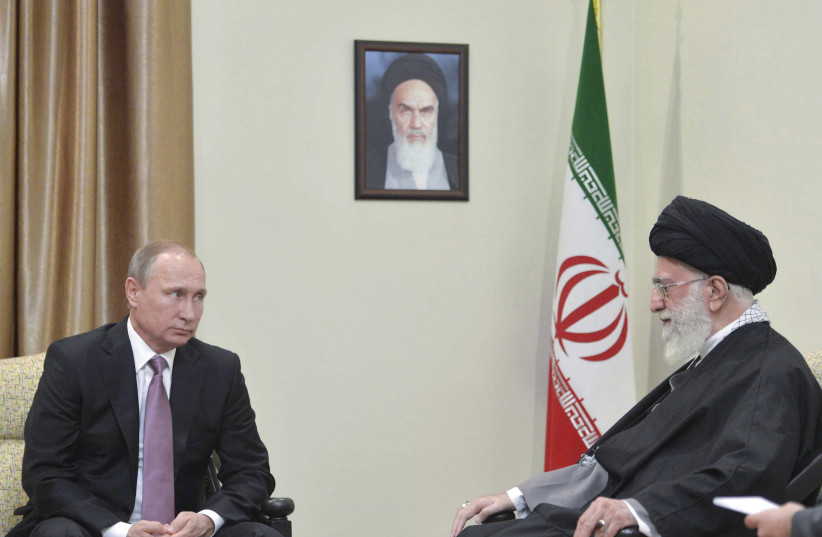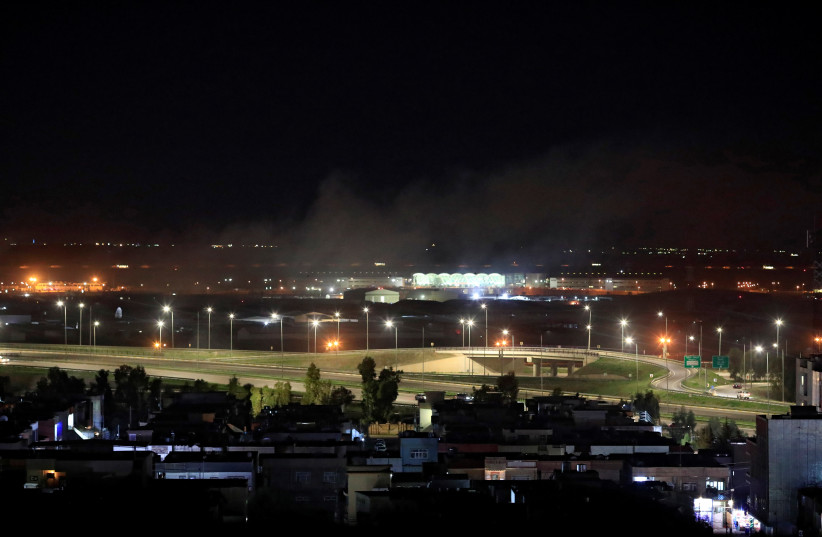Iran is counting on the US being afraid of “war” whiel Russia wants to return Ukraine to its “near abroad.” Iran wants to ride the Russian train as far as it can.

Iran’s attack on Erbil using a dozen large ballistic missiles is a major escalation of affairs in the region.
The missiles targeted key areas, including a new US consulate currently being built, in a message to the US: Iran can do a lot more damage. Had Iran wanted to, it could have aimed more at the airport runways or targeted civilian areas more heavily. Beyond just wreaking havoc, or proving the extent to which it can do so, Iran showed the US the potential it has.
And, it all may be linked to a collapse of the Iran talks. Russia has attempted to use the Iran talks to squeeze more concessions from the US regarding sanctions on Russia. This has angered Iran because Iran wants sanctions relief and is finding itself being waylaid by Russia at the last moment. But, Iran is also looking to Russia for lessons on how to engage with the West, seeing that Russia has used an invasion to show off the fact there is international impunity to warmongering and attacks.
The large ballistic missile barrage on Erbil is not the first time Iran used ballistic missiles like this. It also targeted Kurdish dissidents in 2018 in Koya in northern Iraq’s Kurdistan region. It also used ballistic missiles in 2020 against the US facility at the Al-Asad base in response to the US killing of Iran IRGC Quds Force major-general Qasem Soleimani, meaning that the use of this missile is not new or unprecedented. Iran has even used missiles and drones to target Saudi Arabia and it has also sent missile technology to the Houthis in Iran for use against Saudi Arabia.
How is last night’s attack on Erbil significant?

The large number of missiles and heavy payload from the attack was likely a warm-up for larger attacks — Iran wants to showcase its precision and abilities with these types of missiles. Iran also wants to see if the US will respond.
There is a large chorus of US voices that have argued against US escalation in Ukraine and don’t want “war” with Iran or Russia. Russia has used these voices as well because Russia wants impunity to destroy Ukraine. Russia is counting on the West to be afraid of war and particularly the narrative that any confrontation with Russia is “World War Three” even though there is no evidence that Russia can afford such a large-scale conflict with the West.
So, Russia is selling the “war-war” narrative just as Iran sold the “Iran deal or war” narrative back in 2015. Today, Iran wants to ride the Russian narrative bandwagon and pretend that if the US “escalates” by retaliating against them, then there could be war. The irony here is that Russia and Iran are the aggressors in this case.
In the past, the US has retaliated when pro-Iranian militias killed US or coalition forces in Iraq and Syria. Iran knows the US could retaliate in Syria, a type of “everything goes” country where the US can operate with more impunity. The US would be reticent to retaliate in Iraq because the US doesn’t want to violate “Iraqi sovereignty.” The US will also be cautious about targeting Iran, even though the missiles came directly from Iran.
Iran is testing the US, it wants to see if it will back down, in which case Iran then has a blank check to use more missiles to target the US, Israel, Saudi Arabia, the Gulf, etc.
Iran has already used the Houthis to target the UAE and had Iraqi-based militias target the UAE and Saudi Arabia in the past. Iran has also used drones to target Israel from Iran, last March.
Iran is coming out of the shadows
Iran is using drones and missiles directly fired from Iran itself towards other countries in the region, including targeting Saudi Arabia in September 2019 with no retaliatory response.
Now, Iran has the impression it may be able to try to drive the US out of Erbil in northern Iraq and it is watching what happens in Russia and Ukraine very closely, taking note.
While the US has warned Russia of a tough response against it for invading Ukraine, the White House has also put out messages about not wanting any direct conflict with Russia. Meanwhile, Russia has said it will target supplies of arms going into Ukraine — Russia is testing the West’s resolve, and the US may be backing down.
At the same time, Iran sees that the US wants the JCPOA back and Iran wants to squeeze Washington to come to its terms. Iran is using the Ukraine crisis and also browbeating Russia regarding the Iran deal and using the threat of more deadly attacks to try to get something from the US to see if the US will back down or retaliate. Iran has also noted those in the US who oppose escalation in Ukraine, the ones who argue that “the West is to blame” and argue that “NATO provoked Russia,” with full knowledge that these same voices would be against a conflict with Iran.
Western media are capitalizing on this. For instance, in a New Yorker article where US academic John Mearsheimer is quoted; the headline of the article blames the US and the West for the crisis in Ukraine. The Economist also ran an article titled “John Mearsheimer on why the West is principally responsible for the Ukrainian crisis.” Back in 2008, Foreign Affairs and PBS highlighted another theory by the same academic: “John Mearsheimer, political science professor at the University of Chicago, says a nuclear-armed Iran would bring stability to the region, but Dov Zakheim, former Pentagon official now with the Center for Naval Analyses, says it would trigger an arms race.” And, back in 2007, John Mearsheimer and Stephen Walt wrote a scathing attack on “the Israel Lobby and US Foreign Policy.”
How is this all linked?
The argument is that NATO is responsible for pushing expansion in the early 2000s provoked Russia to attack Ukraine and that Israel is somehow harmful to US foreign policy because of the confrontation with Iran. Also, the argument Iran can bring stability to the Middle East is linked back to the idea that Russia was being innocently provoked. It showcases how Iran hopes to achieve in Iraq what Russia is doing in Ukraine.
Iran is counting on the US being afraid of “war.” It wants to turn Iraq into a “near abroad” and also swallow up Syria, Lebanon and Yemen; Russia wants to return Ukraine to its “near abroad” and counts on US isolationists, the far-left, far-right and “realists” in the West to agree with Russia’s “security needs” — Iran wants to ride that Russian train as far as it can as well.
Content retrieved from: https://www.jpost.com/international/article-701125.